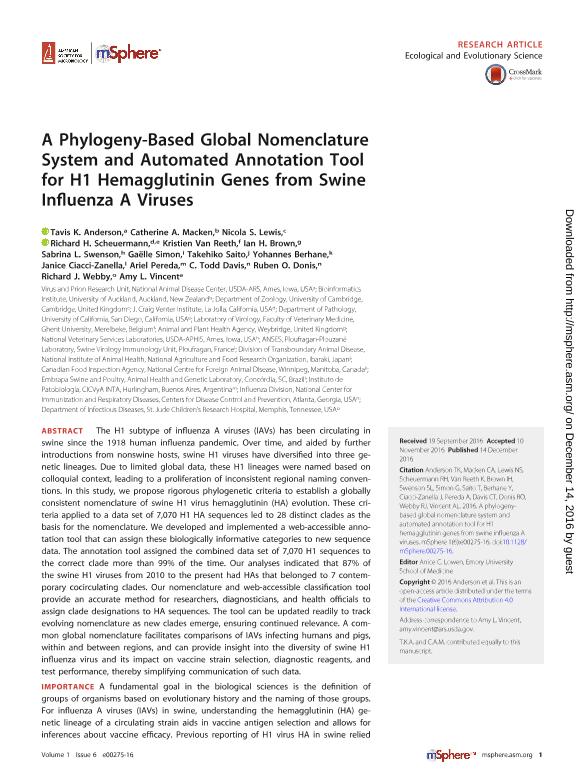Mostrar el registro sencillo del ítem
dc.contributor.author
Anderson, Tavis K.
dc.contributor.author
Macken, Catherine A.
dc.contributor.author
Lewis, Nicola S.
dc.contributor.author
Scheuermann, Richard H.
dc.contributor.author
Van Reeth, Kristien
dc.contributor.author
Brown, Ian H.
dc.contributor.author
Swenson, Sabrina L.
dc.contributor.author
Simon, Gaëlle
dc.contributor.author
Saito, Takehiko
dc.contributor.author
Berhane, Yohannes
dc.contributor.author
Ciacci Zanella, Janice
dc.contributor.author
Pereda, Ariel Julián

dc.contributor.author
Davis, C. Todd
dc.contributor.author
Donis, Ruben O.
dc.contributor.author
Webby, Richard J.
dc.contributor.author
Vincent, Amy L.
dc.date.available
2018-08-15T17:56:15Z
dc.date.issued
2016-11
dc.identifier.citation
Anderson, Tavis K.; Macken, Catherine A.; Lewis, Nicola S.; Scheuermann, Richard H.; Van Reeth, Kristien; et al.; A phylogenybased global nomenclature system and automated annotation tool for H1 hemagglutinin genes from swine influenza A viruses; American Society for Microbiology; mSphere; 1; 6; 11-2016; 1-14
dc.identifier.issn
2379-5042
dc.identifier.uri
http://hdl.handle.net/11336/55659
dc.description.abstract
The H1 subtype of influenza A viruses (IAVs) has been circulating in swine since the 1918 human influenza pandemic. Over time, and aided by further introductions from nonswine hosts, swine H1 viruses have diversified into three genetic lineages. Due to limited global data, these H1 lineages were named based on colloquial context, leading to a proliferation of inconsistent regional naming conventions. In this study, we propose rigorous phylogenetic criteria to establish a globally consistent nomenclature of swine H1 virus hemagglutinin (HA) evolution. These criteria applied to a data set of 7,070 H1 HA sequences led to 28 distinct clades as the basis for the nomenclature. We developed and implemented a web-accessible annotation tool that can assign these biologically informative categories to new sequence data. The annotation tool assigned the combined data set of 7,070 H1 sequences to the correct clade more than 99% of the time. Our analyses indicated that 87% of the swine H1 viruses from 2010 to the present had HAs that belonged to 7 contemporary cocirculating clades. Our nomenclature and web-accessible classification tool provide an accurate method for researchers, diagnosticians, and health officials to assign clade designations to HA sequences. The tool can be updated readily to track evolving nomenclature as new clades emerge, ensuring continued relevance. A common global nomenclature facilitates comparisons of IAVs infecting humans and pigs, within and between regions, and can provide insight into the diversity of swine H1 influenza virus and its impact on vaccine strain selection, diagnostic reagents, and test performance, thereby simplifying communication of such data.
dc.format
application/pdf
dc.language.iso
eng
dc.publisher
American Society for Microbiology

dc.rights
info:eu-repo/semantics/openAccess
dc.rights.uri
https://creativecommons.org/licenses/by-nc-sa/2.5/ar/
dc.subject
H1n1
dc.subject
H1n2
dc.subject
Influenza a Virus
dc.subject
Molecular Epidemiology
dc.subject
Nomenclature
dc.subject
Swine
dc.subject
Virus Evolution
dc.subject.classification
Biología Celular, Microbiología

dc.subject.classification
Ciencias Biológicas

dc.subject.classification
CIENCIAS NATURALES Y EXACTAS

dc.title
A phylogenybased global nomenclature system and automated annotation tool for H1 hemagglutinin genes from swine influenza A viruses
dc.type
info:eu-repo/semantics/article
dc.type
info:ar-repo/semantics/artículo
dc.type
info:eu-repo/semantics/publishedVersion
dc.date.updated
2018-08-15T14:57:33Z
dc.journal.volume
1
dc.journal.number
6
dc.journal.pagination
1-14
dc.journal.pais
Estados Unidos

dc.description.fil
Fil: Anderson, Tavis K.. United States Department of Agriculture; Estados Unidos
dc.description.fil
Fil: Macken, Catherine A.. The University of Auckland; Nueva Zelanda
dc.description.fil
Fil: Lewis, Nicola S.. University of Cambridge; Reino Unido
dc.description.fil
Fil: Scheuermann, Richard H.. University of California at San Diego; Estados Unidos
dc.description.fil
Fil: Van Reeth, Kristien. University of Ghent; Bélgica
dc.description.fil
Fil: Brown, Ian H.. Animal And Plant Health Agency; Reino Unido
dc.description.fil
Fil: Swenson, Sabrina L.. United States Department of Agriculture; Estados Unidos
dc.description.fil
Fil: Simon, Gaëlle. Agence Française de Sécurité Sanitaire Anses; Francia
dc.description.fil
Fil: Saito, Takehiko. National Agriculture And Food Research Organization; Japón
dc.description.fil
Fil: Berhane, Yohannes. Canadian Food Inspection Agency; Canadá
dc.description.fil
Fil: Ciacci Zanella, Janice. Ministerio da Agricultura Pecuaria e Abastecimento de Brasil. Empresa Brasileira de Pesquisa Agropecuaria; Brasil
dc.description.fil
Fil: Pereda, Ariel Julián. Instituto Nacional de Tecnología Agropecuaria; Argentina. Consejo Nacional de Investigaciones Científicas y Técnicas; Argentina
dc.description.fil
Fil: Davis, C. Todd. Centers for Disease Control and Prevention; Estados Unidos
dc.description.fil
Fil: Donis, Ruben O.. Centers for Disease Control and Prevention; Estados Unidos
dc.description.fil
Fil: Webby, Richard J.. St. Jude Childrens Research Hospital; Estados Unidos
dc.description.fil
Fil: Vincent, Amy L.. United States Department of Agriculture; Estados Unidos
dc.journal.title
mSphere
dc.relation.alternativeid
info:eu-repo/semantics/altIdentifier/doi/http://dx.doi.org/10.1128/mSphere.00275-16
dc.relation.alternativeid
info:eu-repo/semantics/altIdentifier/url/https://msphere.asm.org/content/1/6/e00275-16
Archivos asociados
